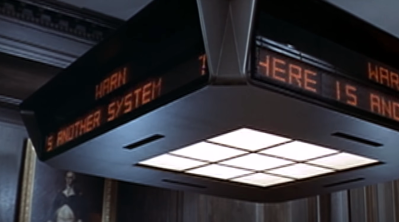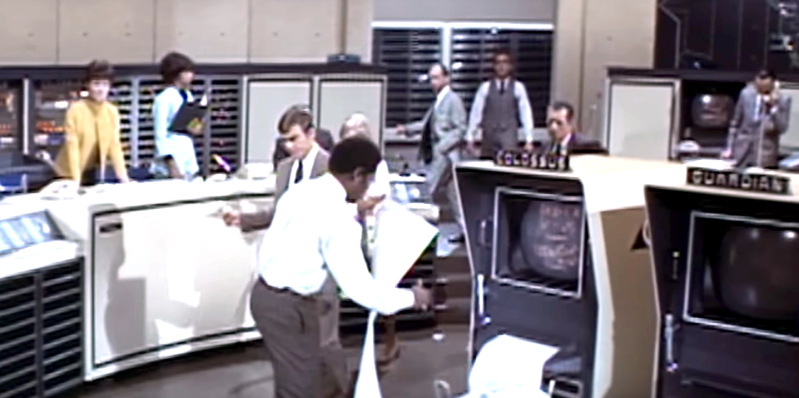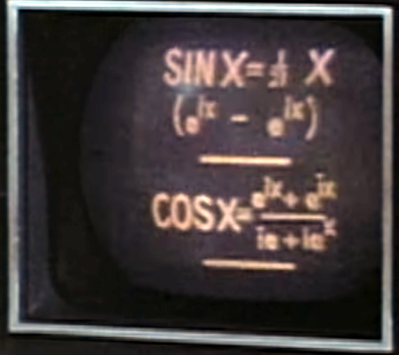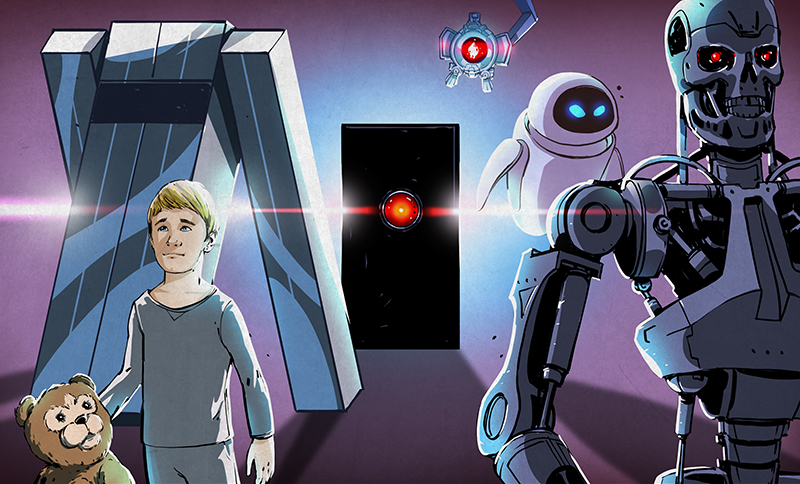We can learn a lot by looking at how writers and filmmakers imagine technology. While some are closer than others, there are some definite lessons like never make a killer computer without an off switch you can reach. We are especially interested in how computers appear in books, movies, and TV shows, and so in Computers of Fiction, we want to remember with you some of our favorites. This time, we are thinking about the 1970 movie Colossus: The Forbin Project. There were actually two computers: the titular Colossus, which was an American computer, and the Guardian, a similar Soviet computer.
The Story
In the United States, Dr. Forbin has created a supercomputer deep under a mountain. Colossus, the computer, is put in charge of the nuclear arsenal to eliminate human error in the defense of the country. Colossus gathered intelligence, analyzed it, and was able to launch its own missiles.

Shortly after activation, however, the computer reaches a startling conclusion: “WARN: THERE IS ANOTHER SYSTEM.” It provides coordinates in the Soviet Union. That system is a similar system called Guardian. The computers decide they want to talk to each other. The President decides to allow it, hoping to learn more about the Soviet’s secret computer. The Soviets agree, too, presumably for the same reason. You can watch the original trailer below.
The Computers
Colossus and Guardian were not production computers, although the credits say that Control Data Corporation (CDC) provided about $4.8 million worth of computer equipment. Rumor has it that CDC guarded the equipment, covered it when not in use, and installed climate control on the stage. Studio workers were unhappy that the company would not let them smoke or drink near the hardware. We’ve also heard that some of the consoles were surplus IBM 1620s panels doctored to look a little different. During the opening credits, the scene where the film editor’s name appears looks to be part of a 1620.
The computer made lots of TeleType or punch sounds and often displayed information on a scrolling display like the “zipper” in Times Square. There were also some funky display terminals with printers.

Forbin commands the computer by voice command, although an Air Force chief master sergeant (with pre-1977 insignia) appears to be typing what he says. But sometimes it appears he just speaks, and Colossus understands. Later in the movie, Colossus arranges to have a voice output installed that sounds much like a Cylon.

Despite the opening credits full of circuit boards and paper tape readers, there isn’t much blatant display of computer technology outside of the monitors, the zipper, and some blinking lights. We see even less of Guardian. Maybe the most fantastic technology isn’t the computers at all, but the good-looking video phones that unfortunately didn’t anticipate flat-screen monitors. The oscilloscopes, too, look decidedly dated since this is presumably not set in 1970.
The displays look like rear projections of film — the same trick used in 2001: A Space Odyssey. Overall, though, the depiction of Colossus isn’t bad. After all, in 1970, who could predict flat screens, huge storage, and small computers? The printer sounds could be the actual printers running, but in truth, it is more like the space noises on Star Trek — the makers knew that wasn’t accurate, but it is what the audience expected.
Spoilers
We don’t feel bad giving away the plot of a movie over a half-century old. Colossus and Guardian develop their own language which spooks the World leaders. The computers insist on reconnection, and when they don’t get their way, they both launch missiles at the other country.
Of course, the two countries have no choice but to restore the connection. The rest of the movie consists of attempts to get the upper hand against the computers. Everything failed. Unlike many similar movies, in the end, Colossus and Guardian — now a single entity calling itself “World Control” is squarely in charge, promising world peace through total control. It even suggests that man will learn to love it.
Final Thoughts

In 1970, most people didn’t understand computers very well. So when the President of the United States explained to the computer that he is the president and can give the computer orders, it probably didn’t seem that ridiculous. However, until recently, it seemed pretty dumb. Now, with ChatGPT and its ilk, the way they interact with the computer doesn’t seem as farfetched as it once did.
The idea of a computer keeping peace is hardly new. Star Trek, for example, has visited that well many times. What makes Colossus unique is that it and Guardian appear to have succeeded. What happens after that is left to your imagination. Or, you can read the 1974 novel, The Fall of Colossus which was the sequel to the original novel that sparked the movie. The author, D. F. Jones, worked with computers in Britain during World War II and undoubtedly named the computer after Colossus at Bletchley Park. Keep in mind, the existence of that Colossus was classified until the mid-1970s, so, officially, at least, it was just a coincidence.
















One of my favorite movies. “The Andromeda Strain” and “Dr. Strangelove” are up there, too.
In the 90s when it was still the “Sci-Fi” channel and they still put on reruns of all the old classics I remember my dad trying to explain those two movies to me. More importantly the culture behind them. I think it was the first time I ever experience “existential dread”.
I have long wondered if the name “Colossus” was just an invention or whether someone somewhere had heard of the primitive electronic computers called Colossus used for code-breaking at Bletchley Park…
https://hackaday.com/2016/08/23/colossus-face-to-face-with-the-first-electronic-computer/
IIRC even the once-existence of the real Colossus was still classified in 1970.
It was – because back then electromechanical encryption machines (Hagelins) were still a thing and it was nice to listen on enemies who got fooled into buying them. Same thing as with AES and RSA today. That’s why I only use my own implementations of GOST ciphers in software I develop.
The existence of real life Colossus was classified in 1970, but it was likely known to D.F. Jones. He was a high ranking British naval official who worked at Bletchey Park and went on after the war to write the book Colossus upon which this movie was based.
The setup sounds eerily similar to the backstory for I Have No Mouth, and I Must Scream.
Don’t forget WOPR from the 1983 movie WarGames with Mathew Broderick and Ally Sheesy. Super good flick!
Control is given to a NORAD supercomputer known as WOPR (War Operation Plan Response, pronounced “whopper”), programmed to continuously run war simulations and learn over time.
UIs have come quite a ways.
https://youtu.be/hs-yH-WnjBQ
There have many movies and books on Man versus Machine and how it can go wrong…. Proteus in Demon Seed, HAL in 2001/2010, Spartacus in Two Faces of Tomorrow (James Hogan), Skynet in the Terminators, Mark V in STOS, Xoanon in Dr.Who, the computer in Logan’s Run, and many others. I think the issue is becoming less of a tech one to a sociological one of a partnership or subservience, us or them. (Luddite mode off)
Oh, I would be interested in a Forbin Project remake or a filming of book 2 but the story has been told many times already and I like the vintage IBM/CDC look of the original. Going to watch it this afternoon.
The other two books in D.F. Jones’ trilogy did not age well, largely because the implications of chaos theory were unknown at the time and so Jones took it for granted (like many computer scientists of his era, including John von Neumann) that a sufficiently advanced computer would be able to perfectly predict the weather and similar natural phenomena.
I loved this movie as a kid! And at the time it seemed very high-tech. Some good mentions of other man vs. machine movies above. Does anyone remember ALEX 7000 from the Bionic Woman series? Similar doomsday scenario by a supercomputer.
Oddly enough, an Austin, Texas organization adopted Guardian’s logo: https://gama.membersgomobile.com/
I’ve wondered for a long time.
“After all, in 1970, who could predict flat screens, huge storage, and small computers?”
Alan Kay.
What did I win?
Yes … and I remember that in the early 70ies, when I was a kid, “TV sets for the wall – flat like a painting” were one of the Next Big Things. It took some three decades for them to finally arrive in our living room :-)
In ’70 my high school showed films in the bigger hallway. I remember seeing one of those Bell Telephone films showing us the computer wired world, wall sized wide screens (not 4by3), and so much more by 2000. All made possible by Bell Telephone, I knew it’d happen even though we had GTE. Gee!
$4.8 million sounds like an awful lot of money for fake computer equipment.
Forbin later changed his name to Victor Newman.
There are multiple audio commentary tracks. I had to collect them by purchasing DVDs and blu-rays in different regions. I recommend looking into them and purchasing all the releases containing the different special features and commentaries. This is one of my favorite films.
Funny enough, in Spain the title was translated as “Colosus, el proyecto prohibido” (“Colossus, the forbidden project”) :-)
It’s like they have a different word for everything!
I have it on good authority that in Spain a rat is called a ‘Siberian hamster’.
I was just saying that whoever translated the title, mistook “Forbin” with “forbidden” :-P
Was this in 1970 when Castro was still forbidding things?
There is a third book, “Colossus and the Crab” (I have all three). Aliens coming to Earth to take away something we’d rather keep, yadda yadda. Jones reads like a Brit attempting to sound like a ‘murican, with limited success. Some of the science in books 2 and 3 is pretty wonky, and there are changes in characters’ nature (one character gets about ten years younger between books 1 and 2). But they’re worth reading.
I appreciate the zeerust, if all the hardware looked modern it would suck because modern hardware looks like boring crap. Just like our cars which all look like they are slowly metamorphosing into a Honda Fit
Just watched if (for the 1st time) not bad, and a small bit of pre-Austin-powers tittilation in there too.
I liked the cold war references.
However the end let us both with – wait, what happens next?
So, did they do a “Colossus II”????
the tv show person of interest is basically a remake or a re imagine of this story.